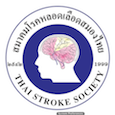Airway and mechanical ventilatory management in acute stroke
Keywords:
endotracheal intubation, positive pressure ventilation, cerebral perfusion pressure, intracranial pressureAbstract
A number of acute stroke patients, with accompanying altered consciousness or pulmonary complications such as neurogenic pulmonary edema or pneumonia, require endotracheal intubation to protect airway from aspiration or assist ventilation using positive pressure ventilation. This article mentions the pathophysiology underlying cerebral perfusion pressure and factors resulting from endotracheal intubation and positive pressure ventilation that affect it. In addition, rapid sequence intubation method, which is commonly used in acute stroke, ventilator setting principles, and complications of mechanical ventilation in acute stroke are also stated.
References
maintained? Neurosurg Focus. 2003;15:E2.
Stocchetti N, Maas AI, Chieregato A, et al. Hyperventilation in head injury: a review. Chest. 2005;127:1812-27.
Obrist WD, Langfitt TW, Jaggi JL, et al. Cerebral blood flow and metabolism in comatose patients with acute head injury. Relationship to intracranial
hypertension. J Neurosurg. 1984;61:241-53.
Torbey M, Bhardwej A. Cerebral blood flow physiology and monitoring. In Suarez J, ed. Critical Care Neurology and Neurosurgery. Totowa, NJ,
Humana Press 2004:23-36.
Masamoto K, Tanishita K. Oxygen transport in brain tissue. J Biomech Eng. 2009;131:074002.
Johnston AJ, Steiner LA, Gupta AK, et al. Cerebral oxygen vasoreactivity and cerebral tissue oxygen reactivity. Br J Anaesth. 2003;90:774-86.
Golanov EV, Reis DJ. Oxygen and cerebral blood flow. In Welch KMA, Caplan LR, Reis DJ, Siesjö BK, Weir B, ed. Primer on Cerebrovascular Diseases.
San Diego, CA,Academic Press 1997:58-60.
Kety SS, Schmidt CF. The Effects of Altered Arterial Tensions of Carbon Dioxide and Oxygen on Cerebral Blood Flow and Cerebral Oxygen
Consumption of Normal Young Men. J Clin Invest. 1948;27:484-92.
Reivich M. Arterial PCO2 and Cerebral Hemodynamics. Am J Physiol. 1964;206:25-35.
Davis SM, Ackerman RH, Correia JA, et al. Cerebral blood flow and cerebrovascular CO2 reactivity in stroke-age normal controls. Neurology. 1983;33:
391-9.
Kontos HA, Raper AJ, Patterson JL. Analysis of vasoactivity of local pH, PCO2 and bicarbonate on pial vessels. Stroke. 1977;8:358-60.
Kontos HA, Wei EP, Raper AJ, et al. Local mechanism of CO2 action of cat pial arterioles. Stroke. 1977;8: 226-9.
Muroi C, Keller M, Pangalu A, et al. Neurogenic pulmonary edema in patients with subarachnoid hemorrhage. J Neurosurg Anesthesiol. 2008;20:188-92.
Junttila E, Ala-Kokko T, Ohtonen P, et al. Neurogenic pulmonary edema in patients with nontraumatic intracerebral hemorrhage: predictors and association with outcome. Anesth Analg. 2013;116: 855-61.
Davison DL, Terek M, Chawla LS. Neurogenic pulmonary edema. Crit Care. 2012;16:212.
Johnston KC, Li JY, Lyden PD, et al. Medical and neurological complications of ischemic stroke: experience from the RANTTAS trial. RANTTAS Investigators. Stroke. 1998;29:447-53.
Finlayson O, Kapral M, Hall R, et al. Risk factors, inpatient care, and outcomes of pneumonia after ischemic stroke. Neurology. 2011;77:1338-45.
Ingeman A, Andersen G, Hundborg HH, et al. Inhospital medical complications, length of stay, and mortality among stroke unit patients. Stroke.
2011;42:3214-8.
Hilker R, Poetter C, Findeisen N, et al. Nosocomial pneumonia after acute stroke: implications for neurological intensive care medicine. Stroke. 2003;34:975-81.
Dziewas R, Ritter M, Schilling M, et al. Pneumonia in acute stroke patients fed by nasogastric tube. J Neurol Neurosurg Psychiatry. 2004;75:852-6.
Bartlett JG. How important are anaerobic bacteria in aspiration pneumonia: when should they be treated and what is optimal therapy. Infect Dis Clin North
Am. 2013;27:149-55.
Finegold SM. Aspiration pneumonia. Rev Infect Dis. 1991;13 Suppl 9:S737-42.
Nanchal R, Khan AJ. Mechanical Ventilation & Airway management. In Torbey MT, ed. Neurocritical care. New York,Cambridge University Press 2010:
68-80.
Gujjar AR, Deibert E, Manno EM, et al. Mechanical ventilation for ischemic stroke and intracerebral hemorrhage: indications, timing, and outcome.
Neurology. 1998;51:447-51.
Perkins ZB, Wittenberg MD, Nevin D, et al. The relationship between head injury severity and hemodynamic response to tracheal intubation. J Trauma
Acute Care Surg. 2013;74:1074-80.
Moulton C, Pennycook AG. Relation between Glasgow coma score and cough reflex. Lancet. 1994;343:1261-2.
Wyte SR, Shapiro HM, Turner P, et al. Ketamineinduced intracranial hypertension. Anesthesiology. 1972;36:174-6.
Langsjo JW, Kaisti KK, Aalto S, et al. Effects of subanesthetic doses of ketamine on regional cerebral blood flow, oxygen consumption, and blood volume
in humans. Anesthesiology. 2003;99:614-23.
Himmelseher S, Durieux ME. Revising a dogma: ketamine for patients with neurological injury? Anesth Analg. 2005;101:524-34.
Sivilotti ML, Ducharme J. Randomized, double-blind study on sedatives and hemodynamics during rapid-sequence intubation in the emergency
department: The SHRED Study. Ann Emerg Med. 1998;31:313-24.
Naguib M, Samarkandi AH, El-Din ME, et al. The dose of succinylcholine required for excellent endotracheal intubating conditions. Anesth Analg.
2006;102:151-5.
Ellis DY, Harris T, Zideman D. Cricoid pressure in emergency department rapid sequence tracheal intubations: a risk-benefit analysis. Ann Emerg Med.
2007;50:653-65.
Marik PE, Monnet X, Teboul JL. Hemodynamic parameters to guide fluid therapy. Ann Intensive Care. 2011;1:1.
Pinsky MR. Cardiovascular issues in respiratory care. Chest. 2005;128:592S-7S.
Ropper AH. Pulmonary Aspects of Neurological Intensive Care. In Ropper AH, Gress DR, Diringer MN, Green DM, Mayer SA, Bleck TP, ed. Neurological
and neurosurgical intensive care. Philadelphia, PA,Lippincott Williams & Wilkins 2004:52-91.
Georgiadis D, Schwarz S, Baumgartner RW, et al. Influence of positive end-expiratory pressure on intracranial pressure and cerebral perfusion pressure
in patients with acute stroke. Stroke. 2001;32:2088-92.
Lima WA, Campelo AR, Gomes RL, et al. The impact of positive end-expiratory pressure on cerebral perfusion pressure in adult patients with hemorrhagic
stroke. Rev Bras Ter Intensiva. 2011;23:291-6.
Davies S, Lindley A. Monitoring the Injured Brain. In Adams JP, Bell D, McKinlay J, ed. Neurocritical Care: A Guide to Practical Management. London,Springer 2010:9-17.
Rincon F, Kang J, Maltenfort M, et al. Association between hyperoxia and mortality after stroke: a multicenter cohort study. Crit Care Med. 2014;42: 387-96.
Slutsky AS, Ranieri VM. Ventilator-Induced Lung Injury. New Engl J Med. 2013;369:2126-36.
Sinclair SE, Altemeier WA, Matute-Bello G, et al. Augmented lung injury due to interaction between hyperoxia and mechanical ventilation. Crit Care Med.
2004;32:2496-501.
Downloads
Published
How to Cite
Issue
Section
License
ข้อความภายในบทความที่ตีพิมพ์ในวารสารสมาคมโรคหลอดเลือดสมองไทยเล่มนี้ ตลอดจนความรับผิดชอบด้านเนื้อหาและการตรวจร่างบทความเป็นของผู้นิพนธ์ ไม่เกี่ยวข้องกับกองบรรณาธิการแต่อย่างใด การนำเนื้อหา ข้อความหรือข้อคิดเห็นของบทความไปเผยแพร่ ต้องได้รับอนุญาตจากกองบรรณาธิการอย่างเป็นลายลักษณ์อักษร ผลงานที่ได้รับการตีพิมพ์ในวารสารเล่มนี้ถือเป็นลิขสิทธิ์ของวารสาร





